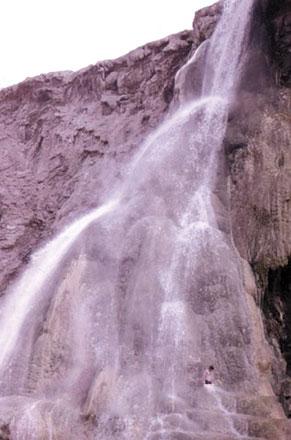You are here
Jordan’s abundance of hot springs can revitalise therapeutic tourism, says scholar
By Saeb Rawashdeh - Aug 15,2022 - Last updated at Aug 20,2022

Wadi Zarqa Ma’in, near Hammat Ma’in (Photo courtesy of ACOR/Rami Khori Collection)
IRBID — Although Jordan is generally perceived as a country with scarce water resources, it is also a place with an abundant presence of thermal and mineral waters, water from which has been used for thousands of years, noted Professor Elias Salameh from University of Jordan at the 15th International Conference on the History and Archaeology of Jordan held in Irbid recently.
“As it’s attested from historical sites along the Jordan Rift Valley, thermal and mineral water has been used for centuries,” said Salameh, pointing to Al Hima Springs in the north, to Ma’in Springs in central Jordan, to Tafileh in the south.
According to expert analysis, the water was used as a therapeutic agent for many diseases such as rheumatism, disturbances in blood circulation, sterility and gynaecology issues and respiratory conditions, as well as applied as a tranquilising agent, said Salameh
He added that around the thermal springs of Jordan, archaeological sites have discovered the use of the thermal springs’ for human settlement and curative purposes.
These springs can boost tourism, the professor said.
The analysed physical and chemical properties of the thermal mineralised springs have been compared with similar sources in the world to examine their potential for curative purposes, and to illustrate the economic relevance of these sources when exploited as spas, Salameh said during his presentation “Curative Water in Jordan-Therapy, Tourism and Archaeology”.
Moreover, the thermal waters along the Jordan Rift Valley enjoy special climatic conditions, with long dry summers and cool wet winters, Salameh said.
The main therapeutic components of the water are iron, lithium and bromide, and the combination of the salt and thermal elements, he said.
In the 1980s, a test was conducted in which 20 patients were sent to these springs for three to four weeks. There, they were medically treated by doctors, and found that their improvement rate exceeded 85 per cent, said Salameh.
Developing these resources to meet international curative spa standards could increase therapeutic tourism, improve the health of visitors and enhance the economy, he said.
“What we expect scientifically is that these springs should be conserved and preserved for spa tourism, otherwise we will lose them forever,” added Salameh.
Related Articles
A Healing Journey to the Lowest Point on Earth: The Dead SeaOumeish Youssef Oumeish2015Pp.
AMMAN — The Global Healthcare Travel Forum (GHTF) 2019, held under the patronage of His Majesty King Abdullah, is set to kick off from Octob
AMMAN — The sixth Medical Tourism World Summit, Conference and Expo 2021, kicked off on Sunday.During the ceremony, attended by Tourism Mini


















